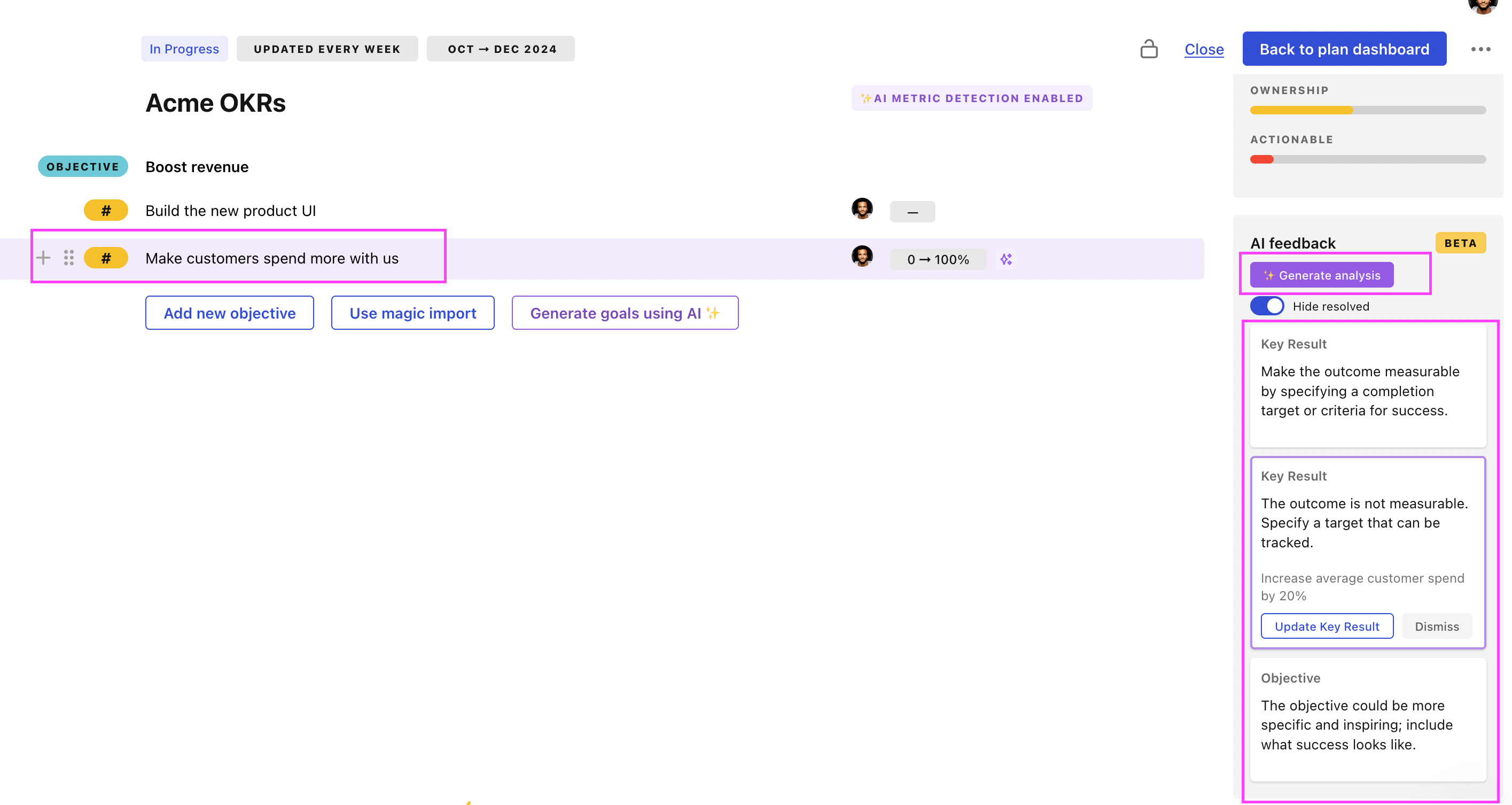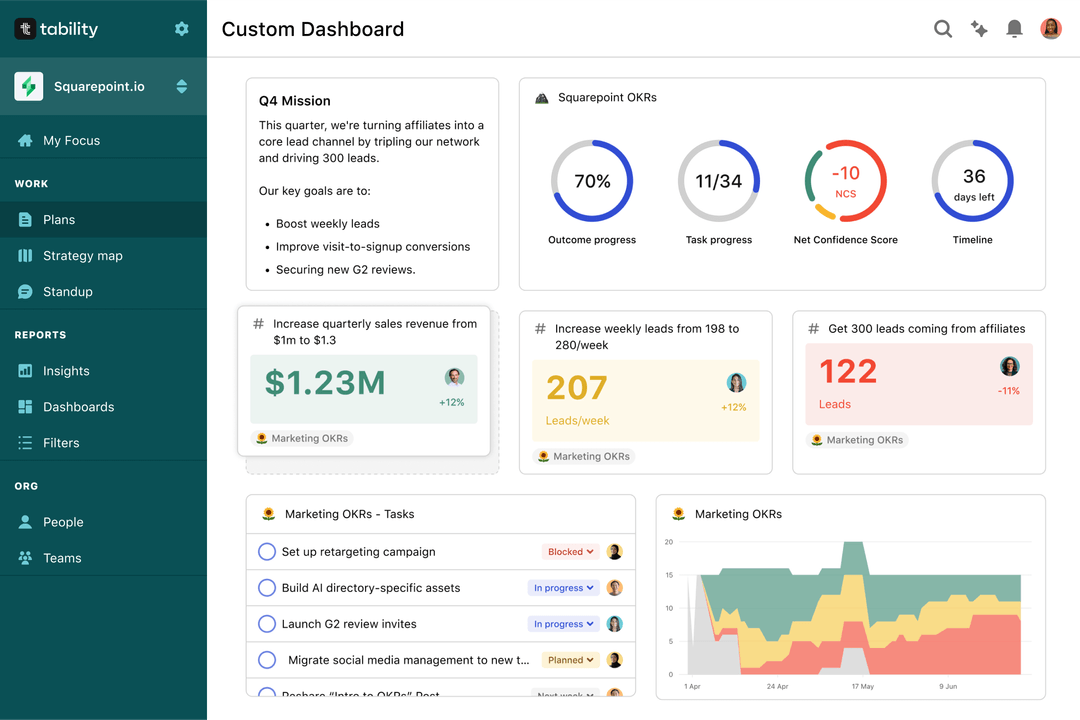Tability is a cheatcode for goal-driven teams. Set perfect OKRs with AI, stay focused on the work that matters.
What are Maintenance Management OKRs?
The Objective and Key Results (OKR) framework is a simple goal-setting methodology that was introduced at Intel by Andy Grove in the 70s. It became popular after John Doerr introduced it to Google in the 90s, and it's now used by teams of all sizes to set and track ambitious goals at scale.
How you write your OKRs can make a huge difference on the impact that your team will have at the end of the quarter. But, it's not always easy to write a quarterly plan that focuses on outcomes instead of projects.
That's why we have created a list of OKRs examples for Maintenance Management to help. You can use any of the templates below as a starting point to write your own goals.
If you want to learn more about the framework, you can read our OKR guide online.
The best tools for writing perfect Maintenance Management OKRs
Here are 2 tools that can help you draft your OKRs in no time.
Tability AI: to generate OKRs based on a prompt
Tability AI allows you to describe your goals in a prompt, and generate a fully editable OKR template in seconds.
- 1. Create a Tability account
- 2. Click on the Generate goals using AI
- 3. Describe your goals in a prompt
- 4. Get your fully editable OKR template
- 5. Publish to start tracking progress and get automated OKR dashboards
Watch the video below to see it in action 👇
Tability Feedback: to improve existing OKRs
You can use Tability's AI feedback to improve your OKRs if you already have existing goals.
- 1. Create your Tability account
- 2. Add your existing OKRs (you can import them from a spreadsheet)
- 3. Click on Generate analysis
- 4. Review the suggestions and decide to accept or dismiss them
- 5. Publish to start tracking progress and get automated OKR dashboards

Tability will scan your OKRs and offer different suggestions to improve them. This can range from a small rewrite of a statement to make it clearer to a complete rewrite of the entire OKR.
Maintenance Management OKRs examples
You'll find below a list of Objectives and Key Results templates for Maintenance Management. We also included strategic projects for each template to make it easier to understand the difference between key results and projects.
Hope you'll find this helpful!
OKRs to enhance productivity in maintenance management
ObjectiveEnhance productivity in maintenance management
KRImprove response time to maintenance requests by 15%
Conduct prioritization training for maintenance staff
Implement an online ticketing system for maintenance requests
Assign specific tasks to each staff member
KRIncrease workflow automation by 30%
Identify manual processes susceptible to automation
Implement automation software in those areas
Train staff on utilizing newly automated systems
KRReduce maintenance downtime by 20%
Regularly update and optimize machinery
Improve training on equipment usage
Implement predictive maintenance strategies
OKRs to enhance effectiveness and efficiency of IT facility management
ObjectiveEnhance effectiveness and efficiency of IT facility management
KRAchieve 10% cost reduction in facility management budget
Negotiate price reductions or discounts with existing vendors
Review current expenses to pinpoint areas with potential for reductions
Implement energy-saving measures to decrease utility bills
KRReduce outstanding facility-related issues by 35%
Prioritize issues based on urgency and impact on operations
Implement effective solutions to address identified high-priority issues
Conduct a comprehensive review of all existing facility-related issues
KRImplement a preventive maintenance routine for all IT infrastructure
Train IT staff on preventive maintenance procedures
Develop a comprehensive maintenance schedule
Identify all IT infrastructure requiring regular maintenance
OKRs to improve Efficiency of O&KR Maintenance Operations
ObjectiveImprove Efficiency of O&KR Maintenance Operations
KRRaise successful first-time repairs to 90% to reduce return visits
Monitor and review each repair case for feedback improvement
Equip team with advanced repair tools and manuals
Implement comprehensive training for repair staff in problem-diagnosis
KRIncrease routine maintenance schedule adherence by 20%
Implement a digital task management tool
Train staff in thorough, consistent maintenance practices
Audit adherence rates regularly
KRDecrease equipment downtime by 15% through proactive, preventive measures
Regularly update and upgrade equipment software
Train staff on proper equipment operation
Implement regular maintenance schedule for all equipment
OKRs to improve efficiency and effectiveness in facilities management
ObjectiveImprove efficiency and effectiveness in facilities management
KRAchieve 90% satisfaction rate in employee facilities survey
Implement updates and improvements based on feedback
Conduct an initial survey to gauge current satisfaction levels
Regularly communicate improvements to employees
KRReduce maintenance response time by 15%
Implement an automated maintenance request tracking system
Increase maintenance staff availability
Train techs on response time reduction strategies
KRDecrease facilities-related expenses by 10%
Regularly maintain and repair equipment to avoid costly replacements
Implement energy-efficient lighting and heating systems
Negotiate lower rates with utilities providers
OKRs to mitigate the risk associated with software maintenance
ObjectiveMitigate the risk associated with software maintenance
KRImplement efficient risk management model for 90% of maintenance projects
Develop a comprehensive risk management model for maintenance projects
Apply the model to current maintenance projects for evaluation
Train project managers in risk management implementation
KRAchieve zero unresolved critical issues for all maintained software
Train staff in proactive problem identification and resolution
Implement regular system checks for software performance
Establish efficient issue reporting and resolution procedures
KRProvide tailored training for all software engineers on identified critical areas
Schedule and conduct tailored training sessions for engineers
Develop customized training programs focusing on these critical areas
Identify critical areas needing tailored training for software engineers
OKRs to achieve consistent and effective dish washing
ObjectiveAchieve consistent and effective dish washing
KRDecrease dish washing time by 25% while maintaining cleanliness standards
Schedule regular dishwasher maintenance to improve performance
Implement a pre-rinsing routine before dishes get heavily soiled
Invest in a more efficient dishwasher model
KRImplement a 100% regular schedule for dish washing to avoid pile-ups
Create a daily dishwashing timetable
Assign every family member a dishwashing day
Regularly check and enforce the schedule
KRReduce water usage by 15% during dish washing
Install water-efficient dishwasher models
Use dishwasher only for full loads
Limit pre-rinse time before dishwashing
OKRs to maintain and improve shadow boards for the entire department
ObjectiveMaintain and improve shadow boards for the entire department
KRDevelop and implement a weekly maintenance plan for all shadow boards
Implement and monitor weekly maintenance plan
Assign maintenance responsibilities to team members
Draft a weekly maintenance schedule for all shadow boards
KRReduce reported instances of misplaced or missing tools by 50%
Provide employee training on tool accountability
Conduct regular tool inventory audits
Implement a tool tracking system for inventory control
KRImprove organization by 30% measured via updated layout or new categorization system
Redesign workspace layout for increased productivity
Classify office supplies using a label system
Implement a new filing system for critical documents
OKRs to maintain continuous operation of critical facilities and equipment
ObjectiveMaintain continuous operation of critical facilities and equipment
KRImplement routine checks to find and rectify faults within 24 hours
Define faults and their rectification methods
Train team in fast fault identification
Develop a daily schedule for routine checks
KRImprove response time of repair teams to equipment failures by 30%
Implement an effective communication structure among the team members
Provide comprehensive training on rapid repair strategies
Undertake regular equipment maintenance and checkups
KRAchieve a monthly average of 95% operational efficiency for all critical infrastructure
Establish key performance indicators to measure efficiency
Train staff on best operational practices
Implement routine maintenance procedures for all critical infrastructure
OKRs to slash office equipment maintenance costs by 10%
ObjectiveSlash office equipment maintenance costs by 10%
KRExecute a monthly inspection to decrease mechanical failures by 20%
Train inspection team on procedures
Implement regular maintenance schedule
Assemble inspection checklist for mechanics
KRImplement a preventive maintenance schedule, reducing repair incidents by 15%
Implement regular maintenance checks and assessments
Identify recurring repair incidents and possible prevention measures
Develop a preventive maintenance plan
KRRetrain staff on efficient equipment use for a 20% usage improvement
Monitor staff equipment usage regularly
Organize comprehensive equipment use training sessions
Implement feedback loop for continuous improvement
OKRs to improve IT Service Management process efficiency and efficacy
ObjectiveImprove IT Service Management process efficiency and efficacy
KRImplement two new service improvement projects
Identify areas in the service sector that need improvement
Commence execution of the project plan steps
Develop detailed project plans for improvements
KRAchieve 95% service request satisfaction
Solicit and incorporate feedback from service users
Regularly train staff to improve quality of customer service
Implement a system for tracking and resolving requests efficiently
KRReduce system-related incidents by 20%
Train staff on correct system usage
Implement regular system maintenance and upgrades
Enhance system security measures
Maintenance Management OKR best practices
Generally speaking, your objectives should be ambitious yet achievable, and your key results should be measurable and time-bound (using the SMART framework can be helpful). It is also recommended to list strategic initiatives under your key results, as it'll help you avoid the common mistake of listing projects in your KRs.
Here are a couple of best practices extracted from our OKR implementation guide 👇
Tip #1: Limit the number of key results
Focus can only be achieve by limiting the number of competing priorities. It is crucial that you take the time to identify where you need to move the needle, and avoid adding business-as-usual activities to your OKRs.
We recommend having 3-4 objectives, and 3-4 key results per objective. A platform like Tability can run audits on your data to help you identify the plans that have too many goals.
Tip #2: Commit to weekly OKR check-ins
Having good goals is only half the effort. You'll get significant more value from your OKRs if you commit to a weekly check-in process.
Being able to see trends for your key results will also keep yourself honest.
Tip #3: No more than 2 yellow statuses in a row
Yes, this is another tip for goal-tracking instead of goal-setting (but you'll get plenty of OKR examples above). But, once you have your goals defined, it will be your ability to keep the right sense of urgency that will make the difference.
As a rule of thumb, it's best to avoid having more than 2 yellow/at risk statuses in a row.
Make a call on the 3rd update. You should be either back on track, or off track. This sounds harsh but it's the best way to signal risks early enough to fix things.
Save hours with automated Maintenance Management OKR dashboards

OKRs without regular progress updates are just KPIs. You'll need to update progress on your OKRs every week to get the full benefits from the framework. Reviewing progress periodically has several advantages:
- It brings the goals back to the top of the mind
- It will highlight poorly set OKRs
- It will surface execution risks
- It improves transparency and accountability
We recommend using a spreadsheet for your first OKRs cycle. You'll need to get familiar with the scoring and tracking first. Then, you can scale your OKRs process by using Tability to save time with automated OKR dashboards, data connectors, and actionable insights.
How to get Tability dashboards:
- 1. Create a Tability account
- 2. Use the importers to add your OKRs (works with any spreadsheet or doc)
- 3. Publish your OKR plan
That's it! Tability will instantly get access to 10+ dashboards to monitor progress, visualise trends, and identify risks early.
More Maintenance Management OKR templates
We have more templates to help you draft your team goals and OKRs.
OKRs to launch a high-quality Real Estate focused newsletter
OKRs to enhance DevOps operations and efficiency
OKRs to ensure sustainability of the financial business
OKRs to achieve a 15% reduction in cloud expenditure while maintaining performance
OKRs to expand expertise and productivity as a Shopify theme developer
OKRs to full deployment of Ember and Abnormal Security tools in SecOps